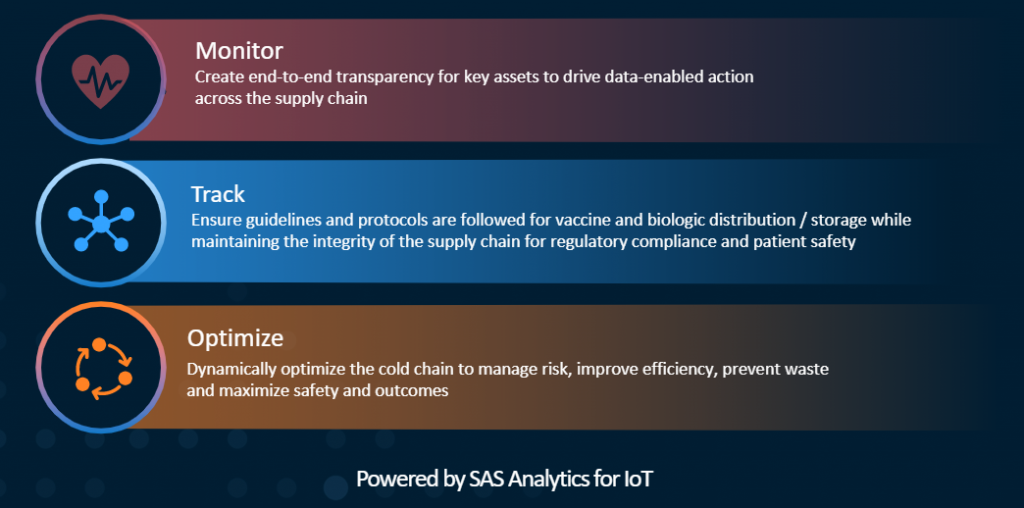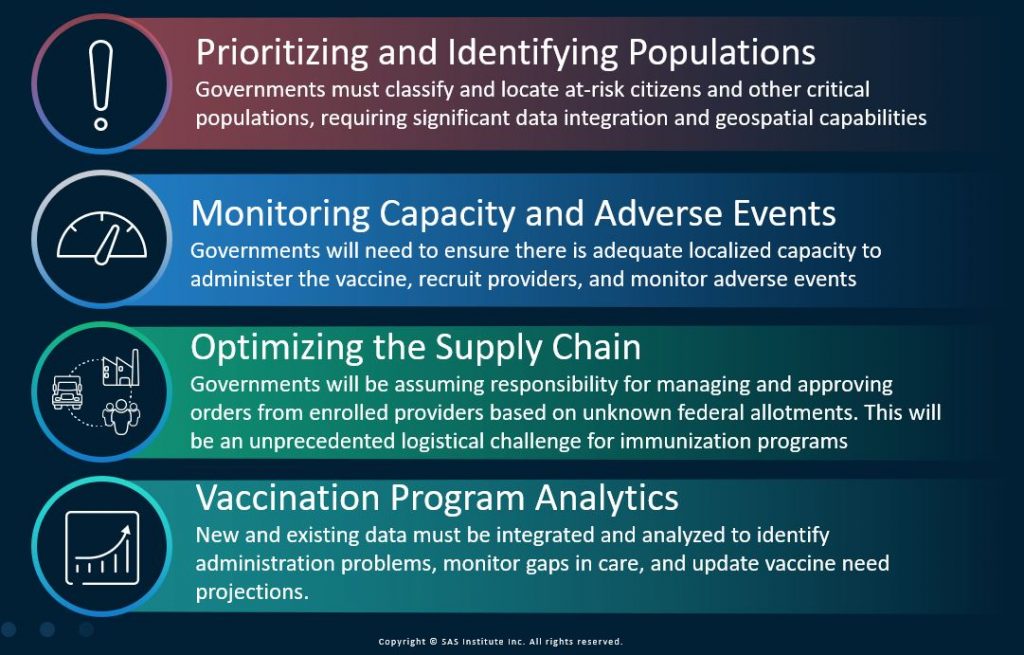The management of the COVID-19 vaccination program is one of the most complex tasks in modern history. Even without the added complications of administering the vaccine during a pandemic, the race to vaccinate the populations who need it most all while maintaining the necessary cold-storage protocols, meeting double dose requirements, and still convincing populations of the vaccine safety, is daunting.
The vaccines available today are unlikely to be available in sufficient quantities to vaccinate the entire population in the near term, which creates the need for nimble, data-driven strategies to optimize limited supplies.
Analytics can be used to:
- Identify the location and concentration of priority populations.
- Monitor the relative adequacy of providers capable of vaccinating critical populations.
- Measure changes in need and demand patterns to optimize supply-chain strategies.
- Track community-based transmission and efficacy.
The storage and transportation of the vaccine is a complex logistical exercise, requiring coordination among governments and providers and the safe transport and storage of vaccines from manufacturers to vaccination sites.
Using analytics to shape strategy and execution
Since the pandemic’s beginning, SAS has partnered with customers in using analytics to:
- Monitor the spread of infection.
- Model future outbreaks.
- Uncover relevant scientific literature.
- Share real-time health insights.
- Optimize supply chains and medical resources.
These same analytical strategies can be used for vaccination programs. Why? Because analytics based on trusted data drives the best decisions. Below of some examples of what we mean.
Develop immediate and long-term vaccination strategies
SAS can help you create a data-driven strategy to identify and estimate critical populations that will benefit the most people. Governments have struggled to balance the need to create an orderly, risk-driven prioritization strategy while quickly administering all of the doses they have been allocated. Integrating data to calculate the size of prioritized populations in given geographic areas enables a data-driven vaccine allocation strategy that maximizes throughput and minimizes wasted dosages.
Locating and estimating the size of these populations will be critical to developing an effective allocation strategy. This complex task can be fraught with technical challenges; for instance, creating an analytically valid estimation that identifies targeted populations across data sources.
To succeed, governments and health agencies will need to integrate data to identify critical populations, enable populations to be further subset to accommodate unknowns in vaccine supply, and model vaccination impact on priority outcomes. Given the variety of public and private organizations collaborating on this response, the best solution will drive open, transparent communication across diverse agencies.
Visual analytics is paramount because showing priority population data on maps can also speed strategy development. Using proximity clustering and hot-spotting technology, leaders can identify population densities to ensure adequate vaccine supply. Epidemiological models can help ensure continued situational awareness, so that prioritization and allocation approaches don’t become reliant on point-in-time data, but are instead part of a continuous-learning system that is responsive to on-the-ground changes in the pandemic.
Wake-Up Call: Modernizing Public Health PracticesMonitor vaccination capacity and adverse events
Identifying and recruiting enough providers to ensure sufficient access to COVID-19 vaccines (especially once supplies increase) will be crucial. SAS has experience working with government health agencies to monitor the adequacy of health care provider networks, a skill set and technology base that can provide agencies with an evidence-driven view of vaccine administration capacity and vaccination goals.
We work with commercial partners worldwide to augment the public health workforce to meet the rising demand for vaccines. Related data such as storage capacity and throughput can be calculated and included for a fuller understanding of network adequacy.
As more data is collected regarding adverse events, SAS continues to help with health surveillance and research for many national health regulatory agencies today. For more insights, watch this on-demand webinar: AI for Supporting Vaccine Adverse Event Reporting, part of the ongoing State of Analytics series.
Optimize supply chain strategies
Health and human service agencies are being asked to allocate vaccine supply based on a range of complex, interrelated factors that include populations served and providers’ capability for storing and refrigeration. Optimizing these distribution strategies while facing fluctuating supplies, evolving needs and changing provider enrollments will require a strong data and analytic approach.
SAS offers end-to-end supply chain analysis to assist agencies in an efficient, coordinated vaccine distribution response. By capturing inventory, demand, capacity and other related data across the distribution chain, you can create models that determine how agencies can optimize allocation strategies while accounting for the dynamic nature of pandemic outbreaks. The outcome is a set of flexible, adaptable plans for vaccination processing, inventory monitoring and distribution.
How we did it: Maintaining COVID-19 vaccine integrity with IoT dataDose administration analytics
Vaccination administrators must report certain data elements in near-real-time (through electronic health records or directly via state immunization information systems). This information is a critical tool in creating rapid-response analytics that can guide decision-making and future planning. Unfortunately, long-term underinvestment in our public health IT infrastructure has led to significant data quality challenges and weak reporting capabilities, which collectively prevent a data-driven vaccination strategy.
Our data management solutions can assist agencies in creating a trusted, consolidated vaccination record. This includes automating tedious and manual processes such as data preparation, data integration and entity resolution to provide analysts more time for treatment and vaccination efforts. With this reconciled vaccination data, SAS can provide analytics to help agencies:
- Predict evolving resource needs across jurisdictions such as states, regions and countries to optimize allocation strategies.
- Monitor uptake to help ensure alignment with anticipated need, provider requests and vaccine distributions.
- Analyze unexpected gaps in vaccination administration to guide outreach and engagement efforts.
- Anticipate barriers to delivering second doses.
- Gain insights on changes in susceptibility, rate of transmission, status population immunity, etc.
Managing a cold chain for biologics
In the US, the CDC has updated the Vaccine Storage and Handling Toolkit to outline the proper conditions for maintaining an effective COVID-19 vaccine under cold-chain processes. Cold chain is a logistics management process for products that require specific refrigerated temperatures from the point of manufacturing through distribution and storage until the vaccine is administered. But how do you collect data along the chain to ensure product safety? New internet-connected sensors now travel along with the vaccines. Collecting and analyzing that data allows administrators to monitor, track and optimize distribution strategies in this multi-layered and complex vaccine rollout.

The path forward
As you read this, shipping and logistics companies are recording data on vaccine temperature and location. Governments are rapidly transforming themselves into organizations capable of allocating, distributing and administering vaccines and their necessary components at massive scale. Retailers (pharmacies) are implementing customer contact programs to help track, administer and verify vaccinations.
The coordination across this various public and private companies is critical for a successful vaccination program. Even though the scale of this operation is historic, the sub-components of the process can be likened to other large, data-driven strategies. For additional information on how SAS helps governments, retailers and logistics companies with complex data analysis, read how:
- SAS delivers free analytics training for COVID researchers
- The Robert Koch Institute quickly established a high-availability information platform with SAS for Germany’s COVID-19 response.
- HCP Engagement: How to overcome challenges to make it a reality
- Riverside County uses SAS to coordinate care across providers, regulators and public safety for integrated whole-person care.
- Volvo Trucks and Mack Trucks use sensor data and SAS® AI solutions to predict maintenance issues and prevent unplanned downtime.


